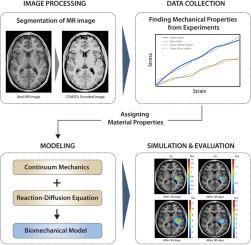Heterogeneous biomechanical/mathematical modeling of spatial prediction of glioblastoma progression using magnetic resonance imaging-based finite element method
IF 4.9
2区 医学
Q1 COMPUTER SCIENCE, INTERDISCIPLINARY APPLICATIONS
引用次数: 0
Abstract
Background and Objective
Brain tumors are one of the most common diseases and causes of death in humans. Since the growth of brain tumors has irreparable risks for the patient, predicting the growth of the tumor and knowing its effect on the brain tissue will increase the efficiency of treatment strategies.
Methods
This study examines brain tumor growth using mathematical modeling based on the Reaction-Diffusion equation and the biomechanical model based on continuum mechanics principles. With the help of the image threshold technique of magnetic resonance images, a heterogeneous and close-to-reality environment of the brain has been modeled and experimental data validated the results to achieve maximum accuracy in predicting growth.
Results
The obtained results have been compared with the reported conventional models to evaluate the presented model. In addition to incorporating the chemotherapy effects in governing equations, the real-time finite element analysis of the stress tensors of the surrounding tissue of tumor cells and considering its role in changing the shape and growth of the tumor has added to the importance and accuracy of the current model.
Conclusions
The comparison of the obtained results with conventional models shows that the heterogeneous model has higher reliability due to the consideration of the appropriate properties for the different regions of the brain. The presented model can contribute to personalized medicine, aid in understanding the dynamics of tumor growth, optimize treatment regimens, and develop adaptive therapy strategies.

利用基于磁共振成像的有限元法建立胶质母细胞瘤进展空间预测的异质生物力学/数学模型
背景和目的脑肿瘤是人类最常见的疾病和死亡原因之一。由于脑肿瘤的生长会给患者带来不可挽回的风险,因此预测肿瘤的生长并了解其对脑组织的影响将提高治疗策略的效率。方法本研究使用基于反应-扩散方程的数学模型和基于连续介质力学原理的生物力学模型来研究脑肿瘤的生长。在磁共振图像的图像阈值技术的帮助下,对大脑的异质和接近真实的环境进行了建模,并通过实验数据对结果进行了验证,以达到预测肿瘤生长的最大准确性。除了将化疗效应纳入控制方程外,对肿瘤细胞周围组织的应力张量进行实时有限元分析,并考虑其在改变肿瘤形状和生长中的作用,也增加了当前模型的重要性和准确性。结论将获得的结果与传统模型进行比较后发现,由于考虑了大脑不同区域的适当属性,异质模型具有更高的可靠性。该模型有助于个性化医疗,有助于了解肿瘤生长动态、优化治疗方案和制定适应性治疗策略。
本文章由计算机程序翻译,如有差异,请以英文原文为准。
求助全文
约1分钟内获得全文
求助全文
来源期刊

Computer methods and programs in biomedicine
工程技术-工程:生物医学
CiteScore
12.30
自引率
6.60%
发文量
601
审稿时长
135 days
期刊介绍:
To encourage the development of formal computing methods, and their application in biomedical research and medical practice, by illustration of fundamental principles in biomedical informatics research; to stimulate basic research into application software design; to report the state of research of biomedical information processing projects; to report new computer methodologies applied in biomedical areas; the eventual distribution of demonstrable software to avoid duplication of effort; to provide a forum for discussion and improvement of existing software; to optimize contact between national organizations and regional user groups by promoting an international exchange of information on formal methods, standards and software in biomedicine.
Computer Methods and Programs in Biomedicine covers computing methodology and software systems derived from computing science for implementation in all aspects of biomedical research and medical practice. It is designed to serve: biochemists; biologists; geneticists; immunologists; neuroscientists; pharmacologists; toxicologists; clinicians; epidemiologists; psychiatrists; psychologists; cardiologists; chemists; (radio)physicists; computer scientists; programmers and systems analysts; biomedical, clinical, electrical and other engineers; teachers of medical informatics and users of educational software.
 求助内容:
求助内容: 应助结果提醒方式:
应助结果提醒方式:


